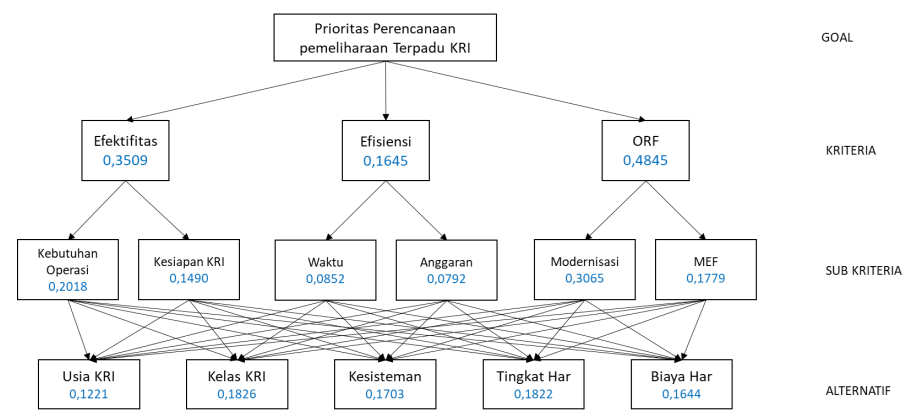Analysis of Integrated Maintenance Priorities for Sewaco and KRI Complex to Support Indonesian Navy Force Readiness
Main Article Content
Abstract
The Indonesian Navy has an obligation to prepare KRIs to always have good operational readiness in technical conditions which include the Sewaco and Komlek fields to support the Operational Readiness Force (ORF), so it is necessary to carry out effective and efficient maintenance and repair strategies. The purpose of the research is to get the right priority scale of KRI maintenance and repair in the preparation of budget planning for the repair of the Navy Organizational Unit in supporting ORF through the Analytical Hierarchy Process (AHP) approach which considers the criteria of Effective, Efficient and ORF against 5 prioritized alternatives. The results of the study that the preparation of budget planning for the repair of the Navy Organizational Unit is closely related to the use of the state budget, where the KRI Class alternative is the top priority in determining maintenance and repair activities in the sewaco and KRI complex fields in the preparation of budget planning for the repair of the Navy Organizational Unit with a priority value of 0.1826..
Downloads
Article Details

This work is licensed under a Creative Commons Attribution 4.0 International License.
Allow anyone to modify, improve, and make derivative works, even for commercial purposes, as long as they credit to you for the original work.
References
H. Bekti Ariyoko, I. Nengah Putra, and O. Sri Suharyo, “ASSESSMENT OF TECHNOLOGY COMPETITIVENESS ABILITIES IN INDONESIAN WAR SHIP IN ASIA.”
R. Mehdi, R. Nidhal, and C. Anis, “Integrated maintenance and control policy based on qualitycontrol,”ComputIndEng,vol.58,no.3,pp.443451,Apr.2010,doi:10.1016/j.cie.2009.11.002.
D. Lin, B. Jin, and D. Chang, “A PSO approach for the integrated maintenance model,” Reliab Eng Syst Saf, vol. 193, Jan. 2020, doi: 10.1016/j.ress.2019.106625.
T. L. Saaty and J. M. Katz, “How to make a decision: The Analytic Hierarchy Process,” 1990.
D. MENDUKUNG KEBERHASILAN PELAKSANAAN TUGAS ANGKUTAN LAUT MILITER Karadona, D. Marsudi, B. Dilianto, and S. Staff Dan Komando Angkatan Laut, “ANALISIS PENENTUAN PRIORITAS PEMELIHARAAN KRI,” 2023.
D. Fahruddin and P. Santoso, “Analisis Perencanaan Pembangunan Fasilitas Pemeliharaan dan Perbaikan Kapal di Natuna.”
A. dan S. Rahman, “Analisa Kepuasan Pelanggan pada Pekerjaan Reparasi Kapal dengan Metode Quality Function Deployment (QFD),” JURNAL TEKNIK ITS , vol. 1, no. 1, pp. 297–302, 2012.
H. M. Park and J. K. Ryan, “Condition-based Inventory Management with Planned and Unplanned Maintenance.”
A. R. Andrade and P. F. Teixeira, “Unplanned-Maintenance needs related to Rail Track Geometry,” Proceedings of the Institution of Civil Engineers: Transport, vol. 167, no. 6, pp. 400–410, Nov. 2014, doi: 10.1680/tran.11.00060.
C. Ren et al., “Intelligent operation, maintenance, and control system for public building: towards infection risk mitigation and energy efficiency,” Sustain Cities Soc, p. 104533, Jun. 2023, doi: 10.1016/j.scs.2023.104533.
M. A. Mirghani, “A framework for costing planned maintenance,” # MCB University Press, 2001. [Online]. Available: http://www.emerald-library.com/ft
I. Lazakis, K. Dikis, A. L. Michala, and G. Theotokatos, “Advanced Ship Systems Condition Monitoring for Enhanced Inspection, Maintenance and Decision Making in Ship Operations,” in Transportation Research Procedia, Elsevier B.V., 2016, pp. 1679–1688. doi: 10.1016/j.trpro.2016.05.133.
R. De Boer, J. M. J. Schutten, and W. H. M. Zijm, “A Decision Support System for Ship Maintenance Capacity Planning.”
B. Martin et al., A strategic assessment of the future of U.S. Navy ship maintenance : challenges and opportunities.
R. Button, B. D. Martin, J. M. Sollinger, A. Tidwell, and National Defense Research Institute (U.S.), Assessment of surface ship maintenance requirements.
I. Lazakis, O. Turan, and S. Aksu, “Increasing ship operational reliability through the implementation of a holistic maintenance management strategy,” Ships and Offshore Structures, vol. 5, no. 4, pp. 337–357, 2010, doi: 10.1080/17445302.2010.480899.
C. Doaly, “OPTIMASI BIAYA PENJADWALAN PENGGANTIAN KOMPONEN SERTA PREVENTIVE MAINTENANCE MENGGUNAKAN MIXED INTEGER NONLINEAR PROGRAMMING DAN SIMULASI MONTE CARLO PADA PT. XYZ,” 2018. [Online]. Available: https://www.researchgate.net/publication/336512760
Y. Garbatov, F. Sisci, and M. Ventura, “Risk-based framework for ship and structural design accounting for maintenance planning,” Ocean Engineering, vol. 166, pp. 12–25, Oct. 2018, doi: 10.1016/j.oceaneng.2018.07.058.
C. Ren et al., “Intelligent operation, maintenance, and control system for public building: towards infection risk mitigation and energy efficiency,” Sustain Cities Soc, p. 104533, Jun. 2023, doi: 10.1016/j.scs.2023.104533.
T. L. Saaty, “WHAT IS THE ANALYTIC HIERARCHY PROCESS?”
T. L. Saaty and J. S. Shang, “An innovative orders-of-magnitude approach to AHP-based mutli-criteria decision making: Prioritizing divergent intangible humane acts,” Eur J Oper Res, vol. 214, no. 3, pp. 703–715, 2011, doi: 10.1016/j.ejor.2011.05.019.
S. Klara, S. Hariyanto, F. Mahmuddin, and P. Shantya, “Maintenance Design of The Main Engine Support Systems on KMP. Kormomolin Under System Dynamics Scheme”, mp, pp. 37-46, Jun. 2023.
Q. Dong and T. L. Saaty, “An analytic hierarchy process model of group consensus,” J Syst Sci Syst Eng, vol. 23, no. 3, pp. 362–374, Sep. 2014, doi: 10.1007/s11518-014-5247-8.

